check engine light FORD TRANSIT 2017 5.G User Guide
[x] Cancel search | Manufacturer: FORD, Model Year: 2017, Model line: TRANSIT, Model: FORD TRANSIT 2017 5.GPages: 484, PDF Size: 11.45 MB
Page 223 of 484
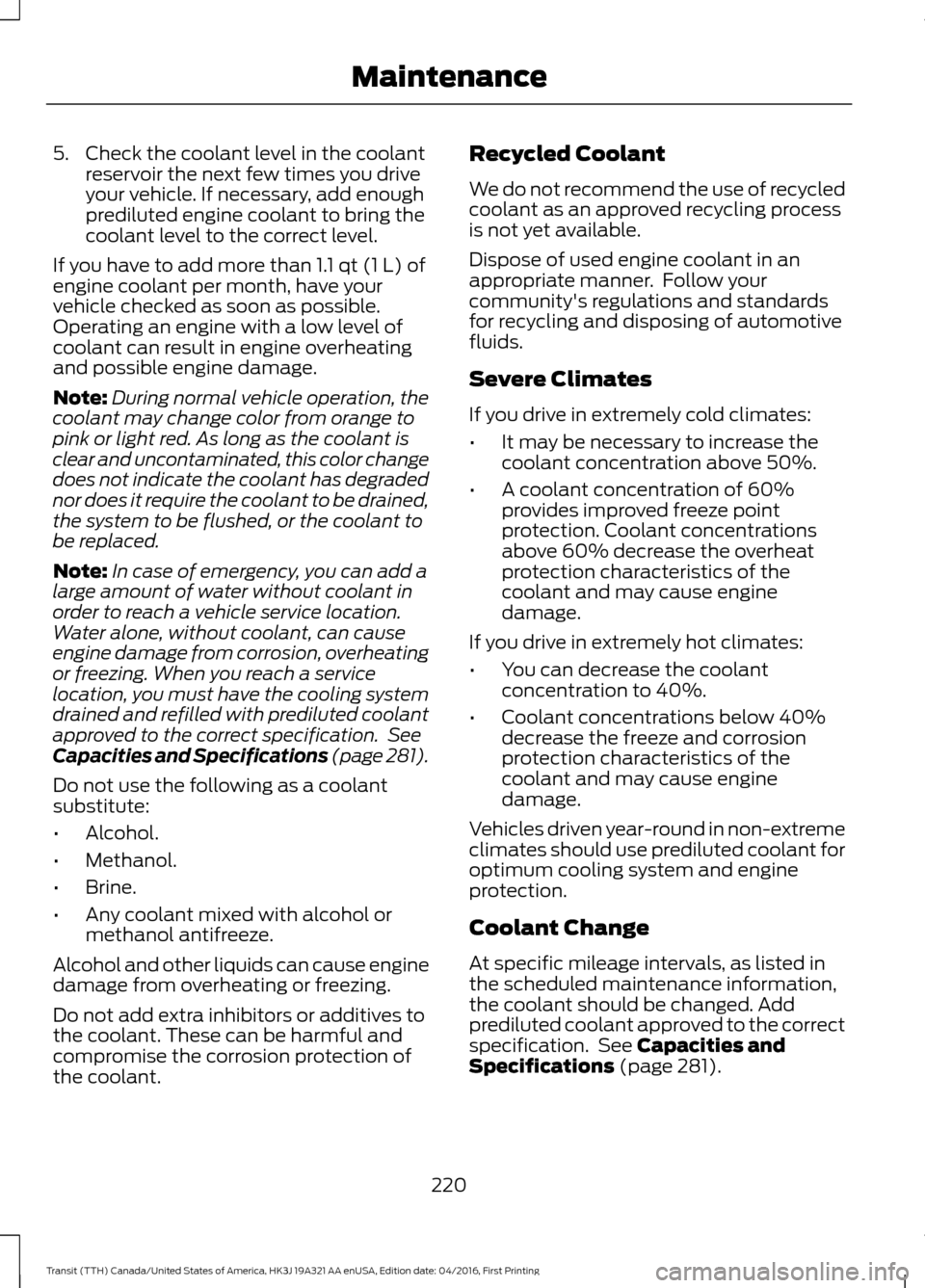
5. Check the coolant level in the coolant
reservoir the next few times you drive
your vehicle. If necessary, add enough
prediluted engine coolant to bring the
coolant level to the correct level.
If you have to add more than 1.1 qt (1 L) of
engine coolant per month, have your
vehicle checked as soon as possible.
Operating an engine with a low level of
coolant can result in engine overheating
and possible engine damage.
Note: During normal vehicle operation, the
coolant may change color from orange to
pink or light red. As long as the coolant is
clear and uncontaminated, this color change
does not indicate the coolant has degraded
nor does it require the coolant to be drained,
the system to be flushed, or the coolant to
be replaced.
Note: In case of emergency, you can add a
large amount of water without coolant in
order to reach a vehicle service location.
Water alone, without coolant, can cause
engine damage from corrosion, overheating
or freezing. When you reach a service
location, you must have the cooling system
drained and refilled with prediluted coolant
approved to the correct specification. See
Capacities and Specifications (page 281).
Do not use the following as a coolant
substitute:
• Alcohol.
• Methanol.
• Brine.
• Any coolant mixed with alcohol or
methanol antifreeze.
Alcohol and other liquids can cause engine
damage from overheating or freezing.
Do not add extra inhibitors or additives to
the coolant. These can be harmful and
compromise the corrosion protection of
the coolant. Recycled Coolant
We do not recommend the use of recycled
coolant as an approved recycling process
is not yet available.
Dispose of used engine coolant in an
appropriate manner. Follow your
community's regulations and standards
for recycling and disposing of automotive
fluids.
Severe Climates
If you drive in extremely cold climates:
•
It may be necessary to increase the
coolant concentration above 50%.
• A coolant concentration of 60%
provides improved freeze point
protection. Coolant concentrations
above 60% decrease the overheat
protection characteristics of the
coolant and may cause engine
damage.
If you drive in extremely hot climates:
• You can decrease the coolant
concentration to 40%.
• Coolant concentrations below 40%
decrease the freeze and corrosion
protection characteristics of the
coolant and may cause engine
damage.
Vehicles driven year-round in non-extreme
climates should use prediluted coolant for
optimum cooling system and engine
protection.
Coolant Change
At specific mileage intervals, as listed in
the scheduled maintenance information,
the coolant should be changed. Add
prediluted coolant approved to the correct
specification. See
Capacities and
Specifications (page 281).
220
Transit (TTH) Canada/United States of America, HK3J 19A321 AA enUSA, Edition date: 04/2016, First Printing Maintenance
Page 248 of 484
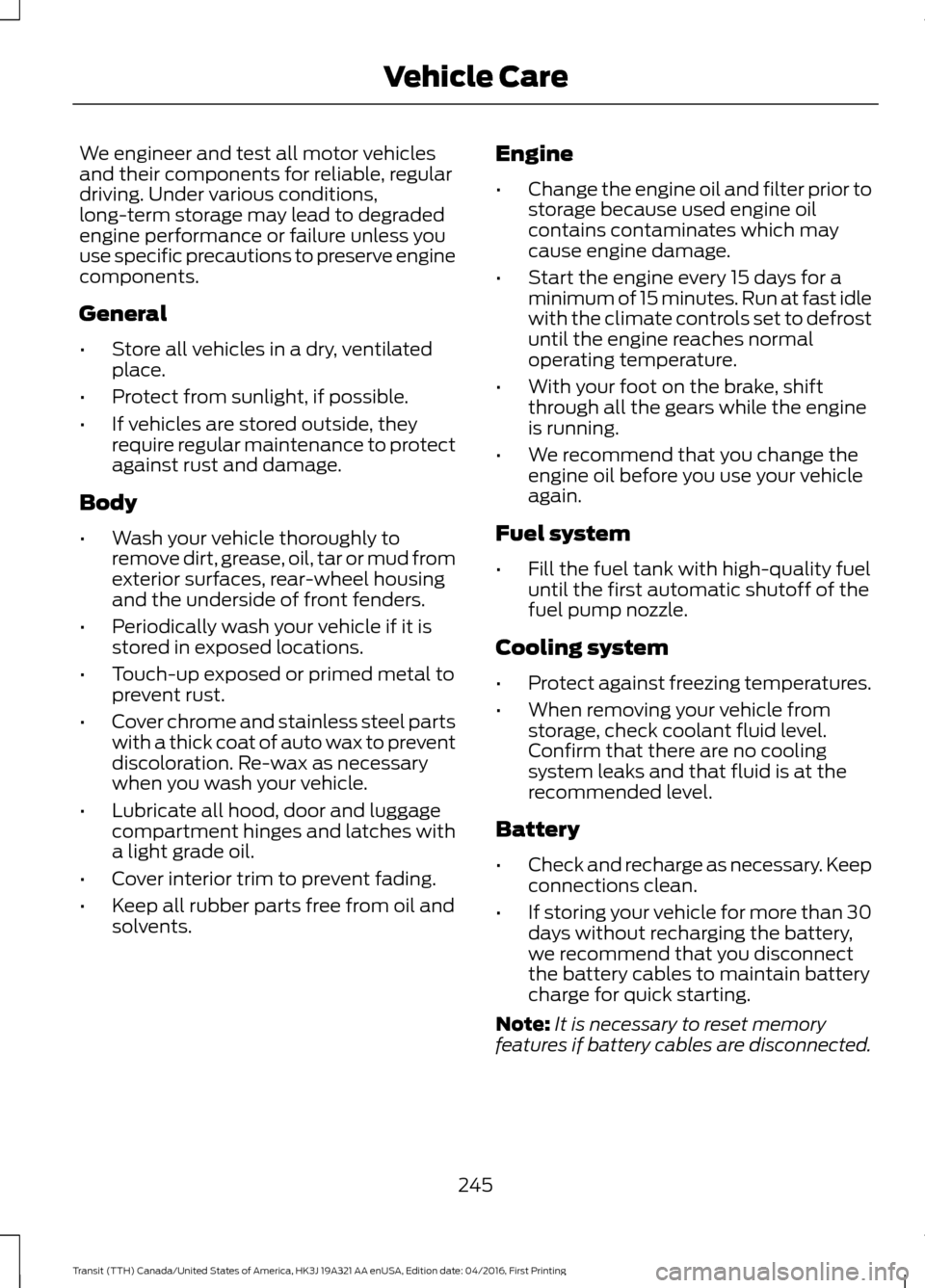
We engineer and test all motor vehicles
and their components for reliable, regular
driving. Under various conditions,
long-term storage may lead to degraded
engine performance or failure unless you
use specific precautions to preserve engine
components.
General
•
Store all vehicles in a dry, ventilated
place.
• Protect from sunlight, if possible.
• If vehicles are stored outside, they
require regular maintenance to protect
against rust and damage.
Body
• Wash your vehicle thoroughly to
remove dirt, grease, oil, tar or mud from
exterior surfaces, rear-wheel housing
and the underside of front fenders.
• Periodically wash your vehicle if it is
stored in exposed locations.
• Touch-up exposed or primed metal to
prevent rust.
• Cover chrome and stainless steel parts
with a thick coat of auto wax to prevent
discoloration. Re-wax as necessary
when you wash your vehicle.
• Lubricate all hood, door and luggage
compartment hinges and latches with
a light grade oil.
• Cover interior trim to prevent fading.
• Keep all rubber parts free from oil and
solvents. Engine
•
Change the engine oil and filter prior to
storage because used engine oil
contains contaminates which may
cause engine damage.
• Start the engine every 15 days for a
minimum of 15 minutes. Run at fast idle
with the climate controls set to defrost
until the engine reaches normal
operating temperature.
• With your foot on the brake, shift
through all the gears while the engine
is running.
• We recommend that you change the
engine oil before you use your vehicle
again.
Fuel system
• Fill the fuel tank with high-quality fuel
until the first automatic shutoff of the
fuel pump nozzle.
Cooling system
• Protect against freezing temperatures.
• When removing your vehicle from
storage, check coolant fluid level.
Confirm that there are no cooling
system leaks and that fluid is at the
recommended level.
Battery
• Check and recharge as necessary. Keep
connections clean.
• If storing your vehicle for more than 30
days without recharging the battery,
we recommend that you disconnect
the battery cables to maintain battery
charge for quick starting.
Note: It is necessary to reset memory
features if battery cables are disconnected.
245
Transit (TTH) Canada/United States of America, HK3J 19A321 AA enUSA, Edition date: 04/2016, First Printing Vehicle Care
Page 273 of 484
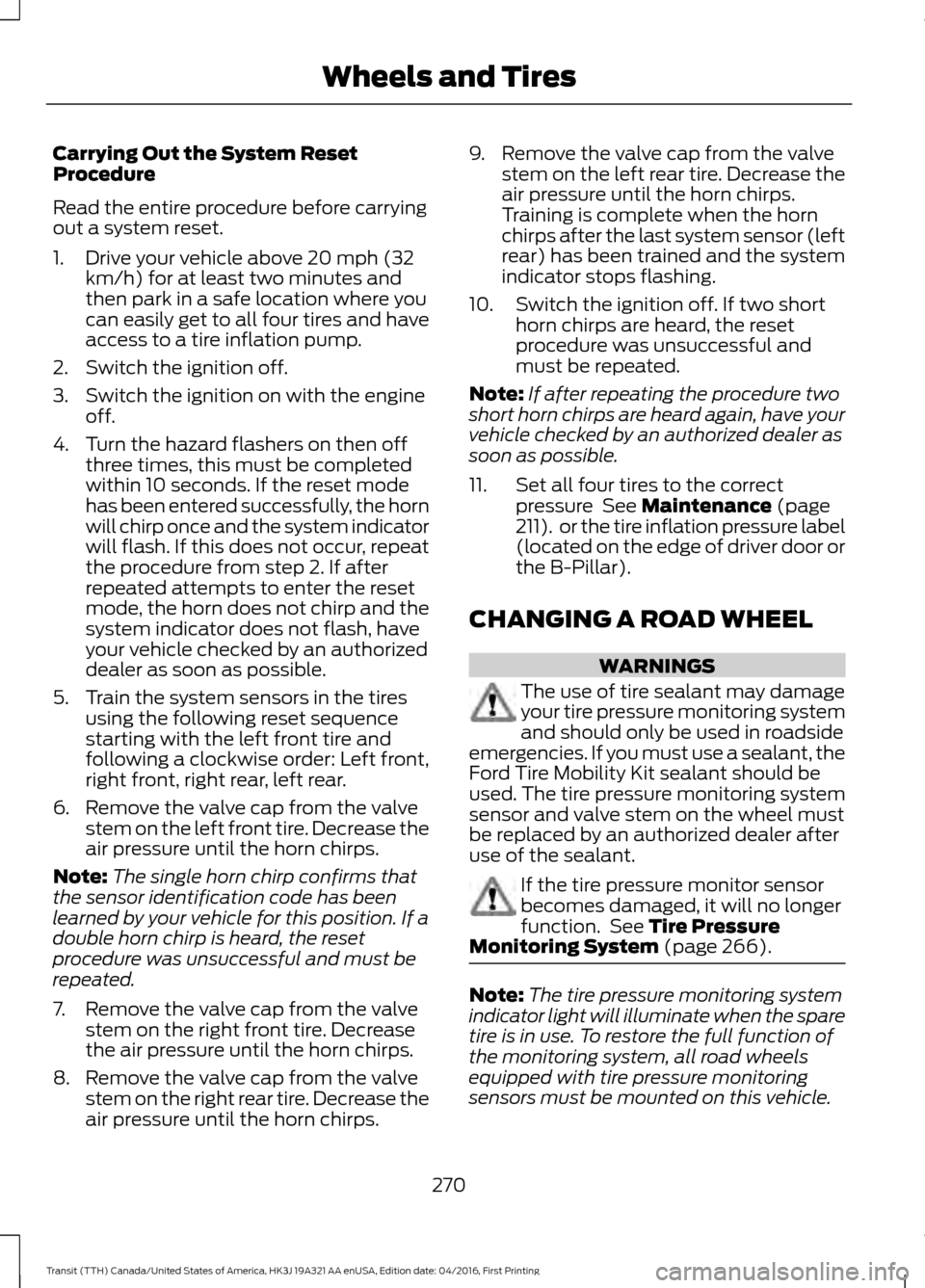
Carrying Out the System Reset
Procedure
Read the entire procedure before carrying
out a system reset.
1. Drive your vehicle above 20 mph (32
km/h) for at least two minutes and
then park in a safe location where you
can easily get to all four tires and have
access to a tire inflation pump.
2. Switch the ignition off.
3. Switch the ignition on with the engine off.
4. Turn the hazard flashers on then off three times, this must be completed
within 10 seconds. If the reset mode
has been entered successfully, the horn
will chirp once and the system indicator
will flash. If this does not occur, repeat
the procedure from step 2. If after
repeated attempts to enter the reset
mode, the horn does not chirp and the
system indicator does not flash, have
your vehicle checked by an authorized
dealer as soon as possible.
5. Train the system sensors in the tires using the following reset sequence
starting with the left front tire and
following a clockwise order: Left front,
right front, right rear, left rear.
6. Remove the valve cap from the valve stem on the left front tire. Decrease the
air pressure until the horn chirps.
Note: The single horn chirp confirms that
the sensor identification code has been
learned by your vehicle for this position. If a
double horn chirp is heard, the reset
procedure was unsuccessful and must be
repeated.
7. Remove the valve cap from the valve stem on the right front tire. Decrease
the air pressure until the horn chirps.
8. Remove the valve cap from the valve stem on the right rear tire. Decrease the
air pressure until the horn chirps. 9. Remove the valve cap from the valve
stem on the left rear tire. Decrease the
air pressure until the horn chirps.
Training is complete when the horn
chirps after the last system sensor (left
rear) has been trained and the system
indicator stops flashing.
10. Switch the ignition off. If two short horn chirps are heard, the reset
procedure was unsuccessful and
must be repeated.
Note: If after repeating the procedure two
short horn chirps are heard again, have your
vehicle checked by an authorized dealer as
soon as possible.
11. Set all four tires to the correct pressure See Maintenance (page
211). or the tire inflation pressure label
(located on the edge of driver door or
the B-Pillar).
CHANGING A ROAD WHEEL WARNINGS
The use of tire sealant may damage
your tire pressure monitoring system
and should only be used in roadside
emergencies. If you must use a sealant, the
Ford Tire Mobility Kit sealant should be
used. The tire pressure monitoring system
sensor and valve stem on the wheel must
be replaced by an authorized dealer after
use of the sealant. If the tire pressure monitor sensor
becomes damaged, it will no longer
function. See
Tire Pressure
Monitoring System (page 266). Note:
The tire pressure monitoring system
indicator light will illuminate when the spare
tire is in use. To restore the full function of
the monitoring system, all road wheels
equipped with tire pressure monitoring
sensors must be mounted on this vehicle.
270
Transit (TTH) Canada/United States of America, HK3J 19A321 AA enUSA, Edition date: 04/2016, First Printing Wheels and Tires
Page 413 of 484
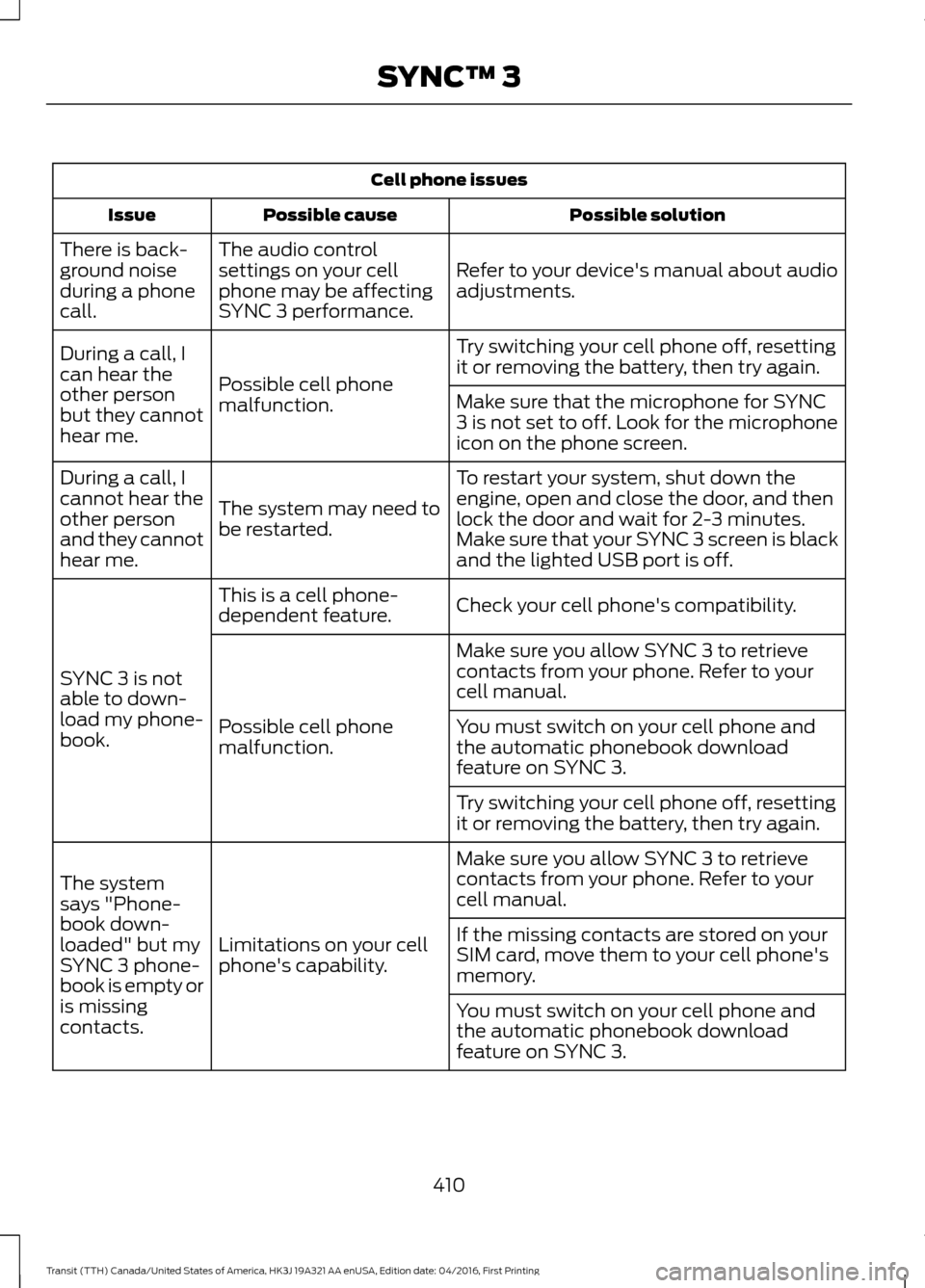
Cell phone issues
Possible solution
Possible cause
Issue
Refer to your device's manual about audio
adjustments.
The audio control
settings on your cell
phone may be affecting
SYNC 3 performance.
There is back-
ground noise
during a phone
call.
Try switching your cell phone off, resetting
it or removing the battery, then try again.
Possible cell phone
malfunction.
During a call, I
can hear the
other person
but they cannot
hear me.
Make sure that the microphone for SYNC
3 is not set to off. Look for the microphone
icon on the phone screen.
To restart your system, shut down the
engine, open and close the door, and then
lock the door and wait for 2-3 minutes.
Make sure that your SYNC 3 screen is black
and the lighted USB port is off.
The system may need to
be restarted.
During a call, I
cannot hear the
other person
and they cannot
hear me.
Check your cell phone's compatibility.
This is a cell phone-
dependent feature.
SYNC 3 is not
able to down-
load my phone-
book. Make sure you allow SYNC 3 to retrieve
contacts from your phone. Refer to your
cell manual.
Possible cell phone
malfunction. You must switch on your cell phone and
the automatic phonebook download
feature on SYNC 3.
Try switching your cell phone off, resetting
it or removing the battery, then try again.
Make sure you allow SYNC 3 to retrieve
contacts from your phone. Refer to your
cell manual.
Limitations on your cell
phone's capability.
The system
says "Phone-
book down-
loaded" but my
SYNC 3 phone-
book is empty or
is missing
contacts. If the missing contacts are stored on your
SIM card, move them to your cell phone's
memory.
You must switch on your cell phone and
the automatic phonebook download
feature on SYNC 3.
410
Transit (TTH) Canada/United States of America, HK3J 19A321 AA enUSA, Edition date: 04/2016, First Printing SYNC™ 3
Page 431 of 484

When the oil change message appears in
the information display, it is time for an oil
change. Make sure you perform the oil
change within two weeks or 500 miles
(800 kilometers) of the message
appearing. Make sure you reset the
Intelligent Oil-Life Monitor after each oil
change. See Changing the Engine Oil
and Oil Filter (page 217).
If your information display resets
prematurely or becomes inoperative, you
should perform the oil change interval at
six months or
5,000 mi (8,000 km) from
your last oil change. Never exceed one year
or
10,000 mi (16,000 km) between oil
change intervals.
All Vehicles
Your vehicle is very sophisticated and built
with multiple, complex, performance
systems. Every manufacturer develops
these systems using different
specifications and performance features.
That is why it is important to rely upon your
dealership to correctly diagnose and repair
your vehicle.
Ford Motor Company has recommended
maintenance intervals for various parts
and component systems based upon
engineering testing. Ford Motor Company
relies upon this testing to determine the
most appropriate mileage for replacement
of oils and fluids to protect your vehicle at
the lowest overall cost to you and
recommends against maintenance
schedules that deviate from the scheduled
maintenance information.
We strongly recommend the use of only
genuine Ford, Motorcraft or
Ford-authorized re-manufactured
replacement parts engineered for your
vehicle. Additives and Chemicals
This owner's manual and the Ford
Workshop Manual list the recommended
additives and chemicals for your vehicle.
We do not recommend using chemicals or
additives not approved by us as part of
your vehicle
’s normal maintenance. Please
consult your warranty information.
Oils, Fluids and Flushing
In many cases, fluid discoloration is a
normal operating characteristic and, by
itself, does not necessarily indicate a
concern or that the fluid needs to be
changed. However, a qualified expert, such
as the factory-trained technicians at your
dealership, should inspect discolored fluids
that also show signs of overheating or
foreign material contamination
immediately.
Make sure to change your vehicle ’s oils and
fluids at the specified intervals or in
conjunction with a repair. Flushing is a
viable way to change fluid for many vehicle
sub-systems during scheduled
maintenance. It is critical that systems are
flushed only with new fluid that is the same
as that required to fill and operate the
system or using a Ford-approved flushing
chemical.
Owner Checks and Services
Make sure you perform the following basic
maintenance checks and inspections every
month or at six-month intervals. Check every month
Engine oil level.
Function of all interior and exterior lights.
Tires (including spare) for wear and
correct pressure.
Windshield washer fluid level.
428
Transit (TTH) Canada/United States of America, HK3J 19A321 AA enUSA, Edition date: 04/2016, First Printing Scheduled Maintenance
Page 437 of 484
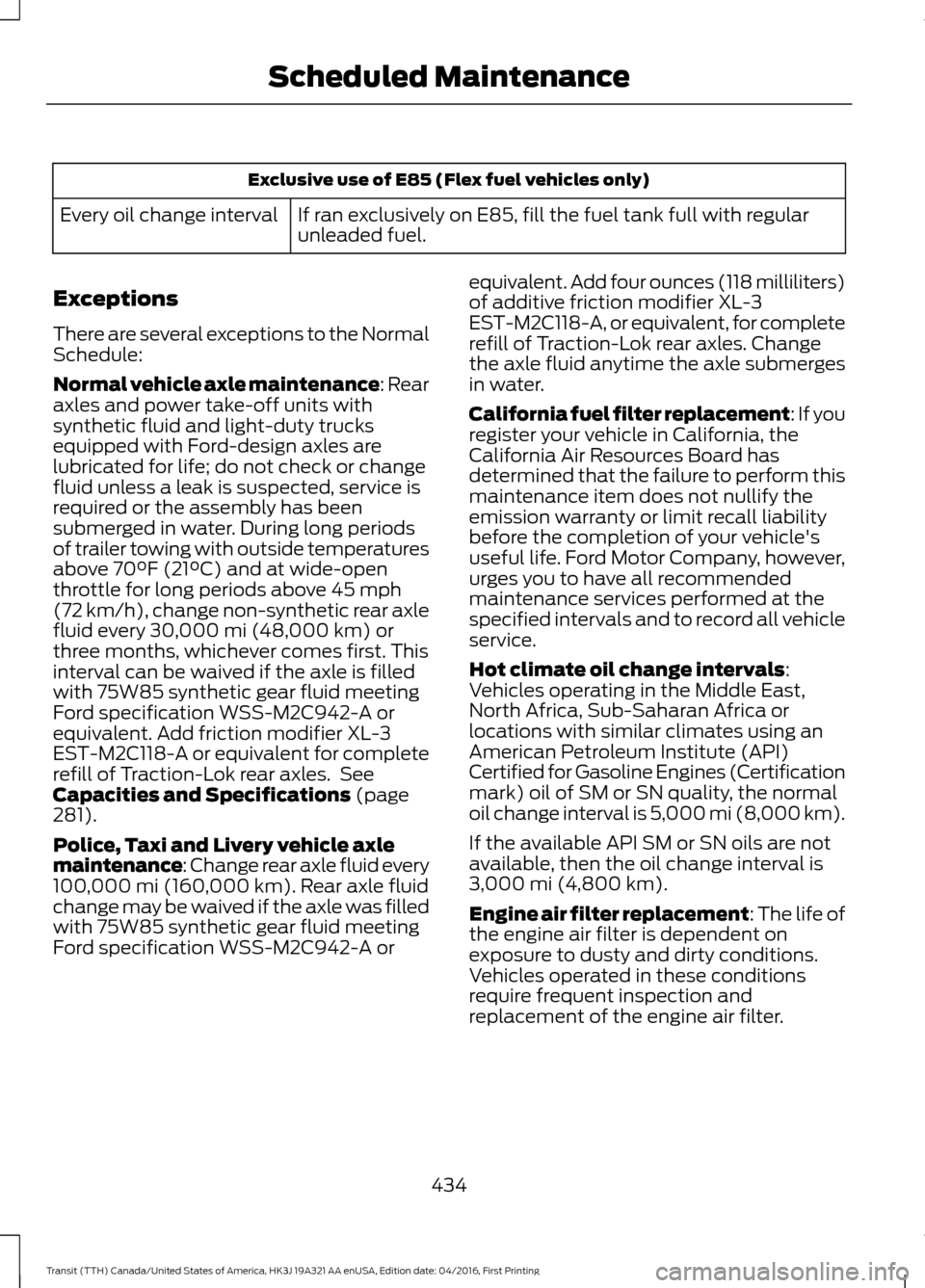
Exclusive use of E85 (Flex fuel vehicles only)
If ran exclusively on E85, fill the fuel tank full with regular
unleaded fuel.
Every oil change interval
Exceptions
There are several exceptions to the Normal
Schedule:
Normal vehicle axle maintenance: Rear
axles and power take-off units with
synthetic fluid and light-duty trucks
equipped with Ford-design axles are
lubricated for life; do not check or change
fluid unless a leak is suspected, service is
required or the assembly has been
submerged in water. During long periods
of trailer towing with outside temperatures
above 70°F (21°C) and at wide-open
throttle for long periods above 45 mph
(72 km/h), change non-synthetic rear axle
fluid every 30,000 mi (48,000 km) or
three months, whichever comes first. This
interval can be waived if the axle is filled
with 75W85 synthetic gear fluid meeting
Ford specification WSS-M2C942-A or
equivalent. Add friction modifier XL-3
EST-M2C118-A or equivalent for complete
refill of Traction-Lok rear axles. See
Capacities and Specifications
(page
281).
Police, Taxi and Livery vehicle axle
maintenance: Change rear axle fluid every
100,000 mi (160,000 km)
. Rear axle fluid
change may be waived if the axle was filled
with 75W85 synthetic gear fluid meeting
Ford specification WSS-M2C942-A or equivalent. Add four ounces (118 milliliters)
of additive friction modifier XL-3
EST-M2C118-A, or equivalent, for complete
refill of Traction-Lok rear axles. Change
the axle fluid anytime the axle submerges
in water.
California fuel filter replacement: If you
register your vehicle in California, the
California Air Resources Board has
determined that the failure to perform this
maintenance item does not nullify the
emission warranty or limit recall liability
before the completion of your vehicle's
useful life. Ford Motor Company, however,
urges you to have all recommended
maintenance services performed at the
specified intervals and to record all vehicle
service.
Hot climate oil change intervals
:
Vehicles operating in the Middle East,
North Africa, Sub-Saharan Africa or
locations with similar climates using an
American Petroleum Institute (API)
Certified for Gasoline Engines (Certification
mark) oil of SM or SN quality, the normal
oil change interval is 5,000 mi (8,000 km)
.
If the available API SM or SN oils are not
available, then the oil change interval is
3,000 mi (4,800 km)
.
Engine air filter replacement: The life of
the engine air filter is dependent on
exposure to dusty and dirty conditions.
Vehicles operated in these conditions
require frequent inspection and
replacement of the engine air filter.
434
Transit (TTH) Canada/United States of America, HK3J 19A321 AA enUSA, Edition date: 04/2016, First Printing Scheduled Maintenance
Page 475 of 484
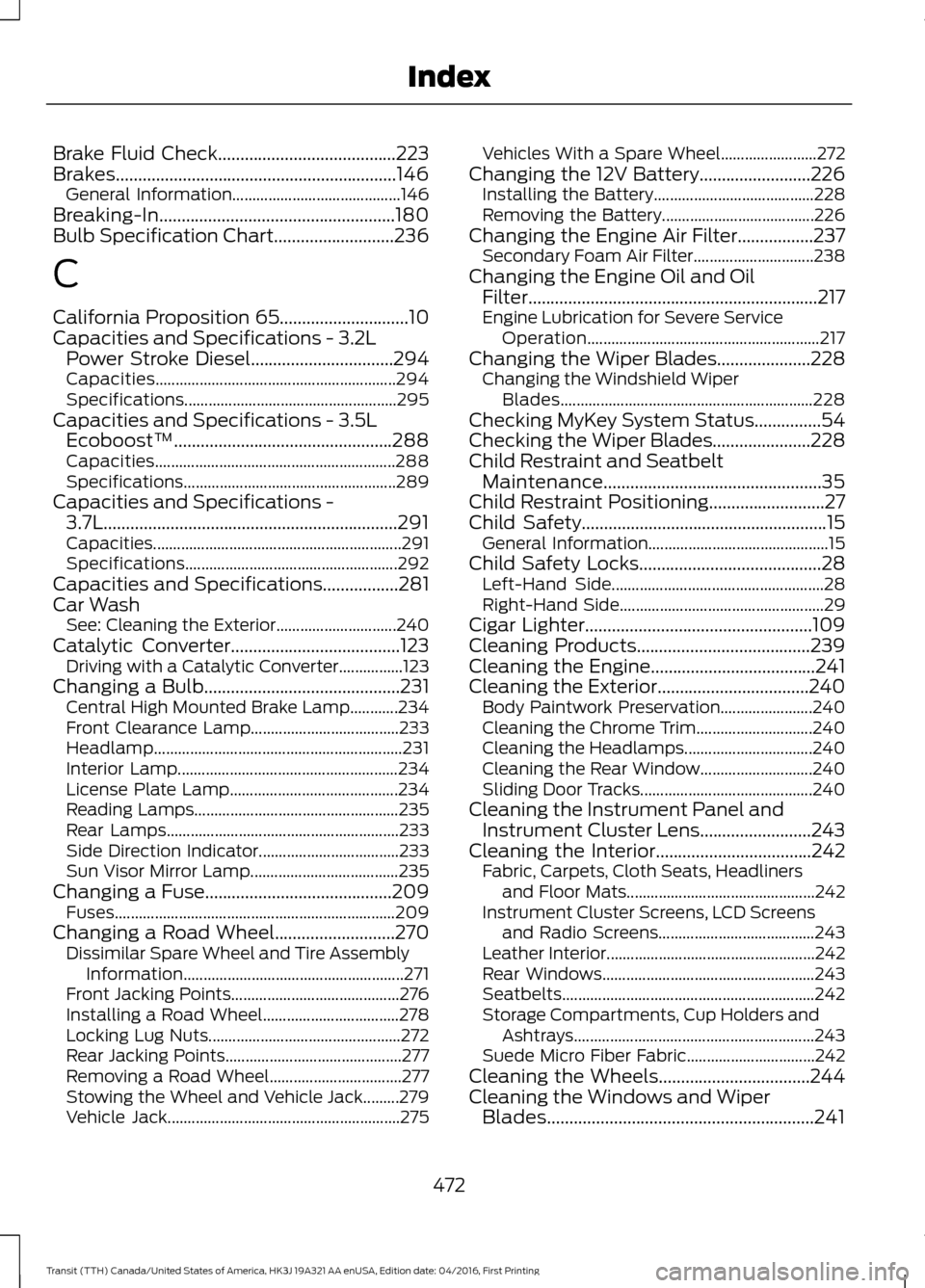
Brake Fluid Check........................................223
Brakes...............................................................146 General Information.......................................... 146
Breaking-In.....................................................180
Bulb Specification Chart...........................236
C
California Proposition 65.............................10
Capacities and Specifications - 3.2L Power Stroke Diesel................................294
Capacities............................................................ 294
Specifications..................................................... 295
Capacities and Specifications - 3.5L Ecoboost™.................................................288
Capacities............................................................ 288
Specifications..................................................... 289
Capacities and Specifications - 3.7L..................................................................291
Capacities.............................................................. 291
Specifications..................................................... 292
Capacities and Specifications
.................281
Car Wash See: Cleaning the Exterior.............................. 240
Catalytic Converter
......................................123
Driving with a Catalytic Converter................123
Changing a Bulb
............................................231
Central High Mounted Brake Lamp............234
Front Clearance Lamp..................................... 233
Headlamp.............................................................. 231
Interior Lamp....................................................... 234
License Plate Lamp.......................................... 234
Reading Lamps................................................... 235
Rear Lamps.......................................................... 233
Side Direction Indicator................................... 233
Sun Visor Mirror Lamp..................................... 235
Changing a Fuse..........................................209 Fuses...................................................................... 209
Changing a Road Wheel...........................270 Dissimilar Spare Wheel and Tire Assembly
Information
....................................................... 271
Front Jacking Points.......................................... 276
Installing a Road Wheel.................................. 278
Locking Lug Nuts................................................ 272
Rear Jacking Points............................................ 277
Removing a Road Wheel................................. 277
Stowing the Wheel and Vehicle Jack.........279
Vehicle Jack.......................................................... 275Vehicles With a Spare Wheel........................
272
Changing the 12V Battery.........................226 Installing the Battery........................................ 228
Removing the Battery...................................... 226
Changing the Engine Air Filter.................237 Secondary Foam Air Filter.............................. 238
Changing the Engine Oil and Oil Filter.................................................................217
Engine Lubrication for Severe Service Operation.......................................................... 217
Changing the Wiper Blades.....................228 Changing the Windshield Wiper
Blades............................................................... 228
Checking MyKey System Status...............54
Checking the Wiper Blades......................228
Child Restraint and Seatbelt Maintenance.................................................35
Child Restraint Positioning
..........................27
Child Safety.......................................................15
General Information............................................. 15
Child Safety Locks.........................................28 Left-Hand Side..................................................... 28
Right-Hand Side................................................... 29
Cigar Lighter
...................................................109
Cleaning Products.......................................239
Cleaning the Engine.....................................241
Cleaning the Exterior..................................240
Body Paintwork Preservation....................... 240
Cleaning the Chrome Trim............................. 240
Cleaning the Headlamps................................ 240
Cleaning the Rear Window............................ 240
Sliding Door Tracks........................................... 240
Cleaning the Instrument Panel and Instrument Cluster Lens.........................243
Cleaning the Interior
...................................242
Fabric, Carpets, Cloth Seats, Headliners
and Floor Mats............................................... 242
Instrument Cluster Screens, LCD Screens and Radio Screens....................................... 243
Leather Interior.................................................... 242
Rear Windows..................................................... 243
Seatbelts............................................................... 242
Storage Compartments, Cup Holders and Ashtrays............................................................ 243
Suede Micro Fiber Fabric................................ 242
Cleaning the Wheels
..................................244
Cleaning the Windows and Wiper Blades............................................................241
472
Transit (TTH) Canada/United States of America, HK3J 19A321 AA enUSA, Edition date: 04/2016, First Printing Index
Page 479 of 484

Headlamp High Beam........................................
73
Lighting Control Positions................................. 72
Parking Lamps....................................................... 72
Lighting...............................................................72 General Information............................................ 72
Load Carrying.................................................164
Load Limit.......................................................164 Special Loading Instructions for Owners of
Pick-up Trucks and Utility-type
Vehicles............................................................. 168
Vehicle Loading - with and without a Trailer................................................................. 164
Load Retaining Fixtures.............................164 Securing Cargo.................................................... 164
Locking and Unlocking
.................................57
Automatic Locking............................................... 61
Automatic Unlocking........................................... 61
Configurable Unlocking...................................... 61
Locking...................................................................... 57
Locking and Unlocking Confirmation............57
Locking and Unlocking the Doors From Inside.................................................................... 57
One-Stage Unlocking.......................................... 61
Opening and Closing the Double Rear Doors.................................................................... 59
Opening and Closing the Sliding Door.........58
Rear Emergency Exit.......................................... 60
Two-Stage Unlocking.......................................... 61
Unlocking................................................................. 57
Zone Re-Locking................................................... 61
Lug Nuts See: Changing a Road Wheel........................ 270
M
Maintenance....................................................211 General Information............................................ 211
Manual Climate Control..............................95
Manual Seats
................................................100
Adjusting the Armrest....................................... 102
Adjusting the Lumbar Support...................... 101
Moving the Seat Backward or Forward............................................................. 100
Recline Adjustment............................................ 101
Media Hub
.......................................................314
Message Center See: Information Displays................................. 85Mirrors
See: Heated Windows and Mirrors................98
See: Windows and Mirrors................................ 76
Mobile Communications Equipment
.......12
Motorcraft Parts - 3.2L Power Stroke Diesel.............................................................285
Motorcraft Parts - 3.5L Ecoboost™.................................................283
Motorcraft Parts - 3.7L..............................284
MyKey Troubleshooting...............................55
MyKey ™..............................................................51
Principle of Operation.......................................... 51
N
Navigation
......................................................386
cityseeker.............................................................. 393
Destination Mode.............................................. 388
Map Mode............................................................ 386
Navigation Map Updates................................ 394
Navigation Menu................................................. 391
SiriusXM Traffic and Travel Link................... 394
Waypoints............................................................ 392
Normal Scheduled Maintenance
..........430
Intelligent Oil-Life Monitor™........................ 430
Normal Maintenance Intervals.................... 430
O
Oil Change Indicator Reset.......................218 Resetting the Oil Life Monitoring
System............................................................... 218
Oil Check See: Engine Oil Check....................................... 216
Opening and Closing the Hood................211 Closing the Hood................................................. 212
Opening the Hood............................................... 211
Ordering Additional Owner's Literature......................................................193
Obtaining a French Owner ’s Manual..........194
Overhead Console
..........................................111
Overhead Storage Compartments................111
P
Parking Aid......................................................152 Switching the Parking Aid System
Off........................................................................\
153
476
Transit (TTH) Canada/United States of America, HK3J 19A321 AA enUSA, Edition date: 04/2016, First Printing Index
Page 483 of 484

Voice Commands for Audio Sources.........343
Using SYNC™ With Your Phone.............319 Accessing Features through the Phone
Menu.................................................................. 324
Accessing Your Phone Settings.................... 327
Bluetooth Devices............................................. 328
Making Calls......................................................... 323
Pairing a Phone for the First Time...............320
Pairing Subsequent Phones........................... 321
Phone Options during an Active Call.........323
Phone Voice Commands................................. 321
Receiving Calls.................................................... 323
System Settings................................................. 329
Text Messaging................................................... 325
Using Traction Control................................149 Switching the System Off............................... 149
System Indicator Lights and Messages.......................................................... 149
Using a Switch..................................................... 149
Using the Information Display Controls............................................................. 149
Using Voice Recognition.............................317 Audio Voice Commands................................. 365
Initiating a Voice Session.................................. 317
Mobile App Voice Commands...................... 368
Navigation Voice Commands........................ 367
Phone Voice Commands............................... 366
SiriusXM Traffic and Travel Link Voice Commands..................................................... 369
System Interaction and Feedback...............318
Voice Settings Commands............................ 369
Using Winter Tires.......................................265
Utilizing the Mediation/Arbitration Program (Canada Only).........................192
V
Vehicle Care
...................................................239
Vehicle Certification Label.......................287
Vehicle Identification Number...............286
Vehicle Storage............................................244
Battery................................................................... 245
Body........................................................................\
245
Brakes.................................................................... 246
Cooling system................................................... 245
Engine.................................................................... 245
Fuel system.......................................................... 245
General.................................................................. 245Miscellaneous.....................................................
246
Removing Vehicle From Storage.................246
Tires........................................................................\
246
Ventilation See: Climate Control........................................... 95
VIN See: Vehicle Identification Number............286
Voice Control
...................................................68
W
Warning Lamps and Indicators..................81 Airbag Warning Lamp.......................................... 81
Anti-Lock Brake System Warning Lamp..................................................................... 81
Brake System Warning Lamp........................... 81
Diesel Warning Lamps........................................ 81
Direction Indicator................................................ 82
Door Ajar.................................................................. 82
Engine Coolant Temperature Warning Lamp.................................................................... 82
Engine Warning Lamps...................................... 82
Fasten Seatbelt Warning Lamp...................... 82
Headlamp High Beam Indicator..................... 82
Ignition Warning Lamp....................................... 82
Lamps on Indicator.............................................. 82
Lane Departure Warning Indicator................82
Low Fuel Level Warning Lamp........................ 83
Low Tire Pressure Warning Lamp.................. 83
Low Washer Fluid Level Warning Lamp.................................................................... 83
Message Center Indicator................................. 83
Oil Pressure Warning Lamp............................. 83
Stability Control and Traction Control Indicator.............................................................. 83
Stability Control and Traction Control Off Warning Lamp.................................................. 83
Transmission Tow/Haul Warning Lamp.................................................................... 83
Washer Fluid Check....................................223
Washers See: Cleaning the Exterior.............................. 240
See: Wipers and Washers................................. 70
Waxing.............................................................240
Wheel Nuts See: Changing a Road Wheel........................ 270
Wheels and Tires..........................................247 General Information.......................................... 247
480
Transit (TTH) Canada/United States of America, HK3J 19A321 AA enUSA, Edition date: 04/2016, First Printing Index